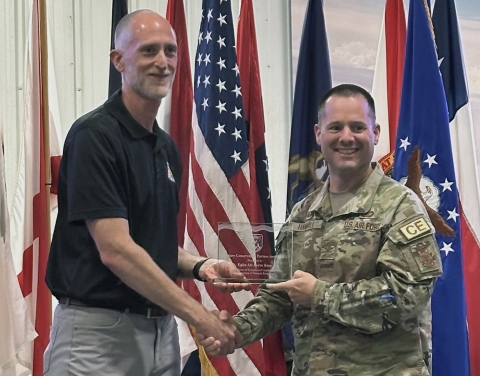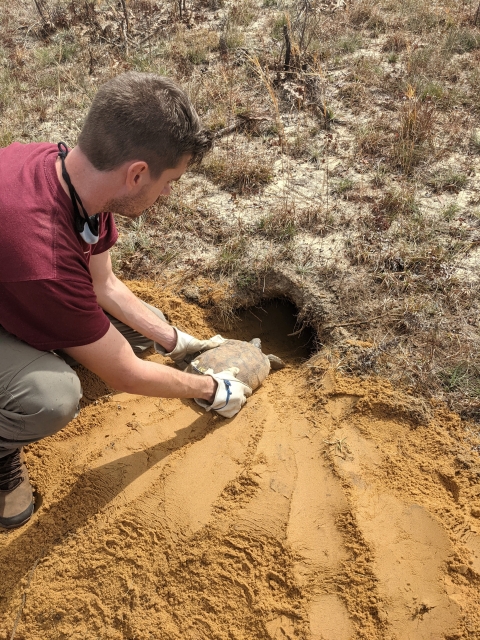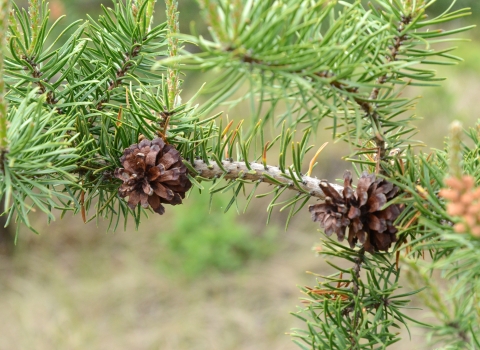Each year, the U.S. Fish and Wildlife Service recognizes a military installation with its Military Conservation Partner of the Year Award, which highlights the conservation efforts and impacts of the collaboration among the Department of Defense, the Service, and other partners.
This year, the Service selected Eglin Air Force Base for proactive and innovative approach to conserving a variety of native fish and wildlife and the habitats on the installation where they live.
“We are proud to recognize Eglin Air Force Base’s dedication to conservation alongside their military duties,” said Mike Oetker, regional director of the Service’s Southeast Region. “The base hosts a variety of fish and wildlife, including threatened and endangered species, and has achieved some significant accomplishments. We honor Eglin for their commitment to preservation and the resources they've invested – showing that conservation and military training and testing can work well together.”
As Eglin ensures military operational needs and national security needs are met, military leaders also work closely with the U.S. Fish and Wildlife Service. Eglin has partnered to protect wildlife – some of which are endangered or threatened – and native species, minimize disruption to their natural homes, and stay on top of invasive species invasive species
An invasive species is any plant or animal that has spread or been introduced into a new area where they are, or could, cause harm to the environment, economy, or human, animal, or plant health. Their unwelcome presence can destroy ecosystems and cost millions of dollars.
Learn more about invasive species .
“I want to thank the Service and our Natural Resources Team for their dedication to environmental stewardship and their strategic management of the natural resources across the Eglin Test and Training Complex," said Col. Jeremiah Hammill, commander, 96th Civil Engineer Group when he accepted the award May 15. “This team’s diligence, collaboration, and conservation plans prioritized wildlife, fire, and forestry management activities to ensure the operational capabilities of the complex water and land resources that support Eglin's test and training missions.”
A variety of state and federally listed species can be found at Eglin including the critically endangered reticulated flatwoods salamander. Eglin is home to more than half of all known breeding ponds for this species. With funding from the Florida Fish and Wildlife Conservation Commission (FWC) and volunteer support, they installed 12,300 feet of fencing to prevent feral hogs from damaging the salamander’s breeding habitat, and they restored approximately 23 percent of the total historically occupied breeding habitat for this species on the base. Staff also took innovative steps to release reticulated flatwoods salamander eggs and larvae into two unoccupied breeding wetlands. The released salamanders recolonized these ponds demonstrating it is possible to successfully reintroduce this species to a new habitat. This pioneering work done at Eglin demonstrates that the salamander can be re-introduced throughout its former range, which will be necessary to recover the species.
One small fish living on the base, the Okaloosa darter, was recently removed Federal List of Endangered and Threatened wildlife. Eglin’s efforts and their Integrated Natural Resources Management Plan, which includes specific goals and objectives to improve habitat, were driving forces behind the fish’s recovery. The base has reduced erosion into streams, removed fish passage fish passage
Fish passage is the ability of fish or other aquatic species to move freely throughout their life to find food, reproduce, and complete their natural migration cycles. Millions of barriers to fish passage across the country are fragmenting habitat and leading to species declines. The U.S. Fish and Wildlife Service's National Fish Passage Program is working to reconnect watersheds to benefit both wildlife and people.
Learn more about fish passage barriers and restored more than 480 acres of land on the base, reconnecting stream habitat for the darter.
Red-cockaded woodpeckers have also benefitted from conservation efforts on the base and are now flourishing there. Through a combination of conservation practices and forest management, the Air Force has helped successfully increase the population of the red-cockaded woodpecker. To achieve this population increase, Eglin worked with the Service and other partners to conduct surveys, create artificial cavities for the woodpecker to reside, monitor the population and participate in a translocation partnership, helping to move more than 200 young woodpeckers to other locations to help establish new populations. Eglin met the recovery goal of 350 potential breeding groups in 2009 but has continued to bolster the population to the current count of 585.
Under an Agreement with the FWC, Eglin began an intensive effort to help state threatened gopher tortoises by relocating tortoises displaced by development projects elsewhere in Florida to the base. As a result, Eglin has provided homes to more than 10,000 gopher tortoises, with plans to achieve the goal of 20,000 tortoises coming years. Re-establishing viable populations of tortoises within the installation, will help prevent the gopher tortoise from federal listing in the eastern part of its range. Increasing the number of tortoises on the base helps with indigo snake recovery since the federally threatened snakes often use tortoise burrows as a refuge.
Eglin’s combined use of land-management techniques, forestry, and restoration have improved species diversity. The long-leaf pine ecosystem at the base has benefited from the use of regularly scheduled prescribed fire. Eglin typically burns between 75,000 and 100,000 acres per year. This reduces the risk from wildfires and benefits fire dependent flora and fauna. Eglin’s erosion control program has completed more than 700 individual projects to decrease erosion and each year has eliminated approximately 75,000 tons of sediment from entering watersheds used by the Okaloosa darter.
In addition to helping fish and wildlife, Eglin supports robust outdoor education and recreation programs including hunting, fishing, hiking, birdwatching, mountain biking, camping, paddling and disc golf. The annual fishing rodeo at Eglin is held at the site of an Okaloosa darter stream restoration and each year provides a quality fishing experience for 300 young anglers in an endangered species conservation setting. The Eglin volunteer program enlists community support for a variety of natural resources programs. In 2022 alone, the Eglin volunteer program provided over 6,000 workhours from almost 500 volunteers to support beach and reservation cleanups, species monitoring, habitat restoration projects, and hunting and fishing programs.
Military and Service colleagues said they look forward to building on these award-winning accomplishments and exploring other innovative ways to collaborate in conservation.






